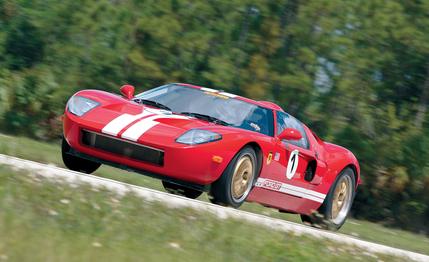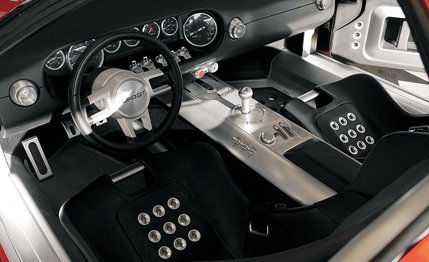 First Drive Review
First Drive Review


Even after CEO Bill Ford announced production plans for the Ford GT in February 2002, a month after the GT40 concept debuted at the Detroit auto show, we had our doubts. With Ford in its worst economic slump in 20 years, would the company, could the company, really build a limited run of 500-hp exotic sports cars?
After meeting with the development team and driving three prototypes, we can assure you that Ford is completely serious about this car. Three GTs, as they're now called, correct in appearance and hardware but not in every development detail, debuted at Ford's centennial celebration in Dearborn in June. Production-car deliveries will follow in the spring of 2004.
John Coletti, Ford's well-known performance guru and the head of Special Vehicle Team Engineering, leads the 140-person Ford group that will make this powerful sports car a reality. Neil Ressler, Ford's retired chief technology officer and one of the smartest auto execs we've ever met, serves as the GT's behind-the-scenes godfather. The development chief is Neil Hannemann, a former Chrysler engineer whose résumé lists development work on the Viper and the Saleen S7, as well as several SCCA championships.
Hannemann and his crew spent last winter at Ford's Florida Evaluation Center, where they have been flogging three GT development mules. All three cars are, at best, only approximations of the production GT. Their exterior shapes are about right, but their interiors are crude mockups, with an SVT Mustang instrument cluster grafted onto a plain, industrial-looking dash.

The production GT will use a structure that is conceptually similar to that of the Ferrari 360 Modena, with large castings at all four suspension attachment points, linked together with a network of extruded aluminum tubes—each optimized in size and shape to achieve the required stiffness and strength at minimal weight.
The suspension will consist of unequal-length aluminum control arms in conjunction with front and rear anti-roll bars and coil-over pressurized monotube shocks from Dynamic Suspensions. One-piece brake calipers acting on giant vented and cross-drilled rotors—14.0 inches up front and 13.2 inches at the rear—will stop the car.

Clearly, there will not be any platform sharing going on in the GT. But to save a buck here and there, the GT employs some corporate parts. The upper ball joints, the rear brake rotors and calipers, and the ZF steering gear are all from Aston Martin. Its rear suspension uses toe-control links from the Jaguar S-type. The lower ball joints in front are from the Lincoln Town Car, and the steering column is a Focus part.